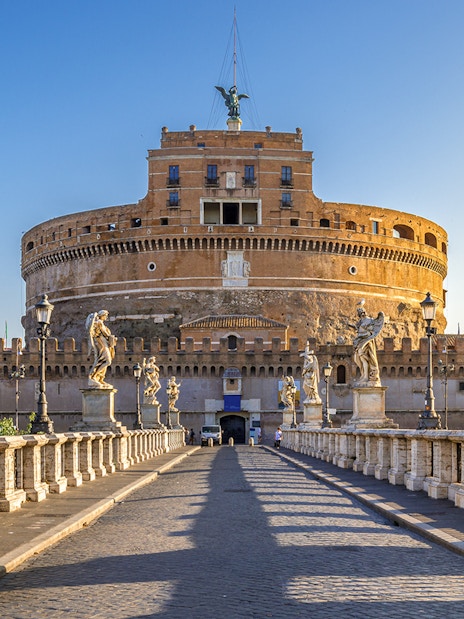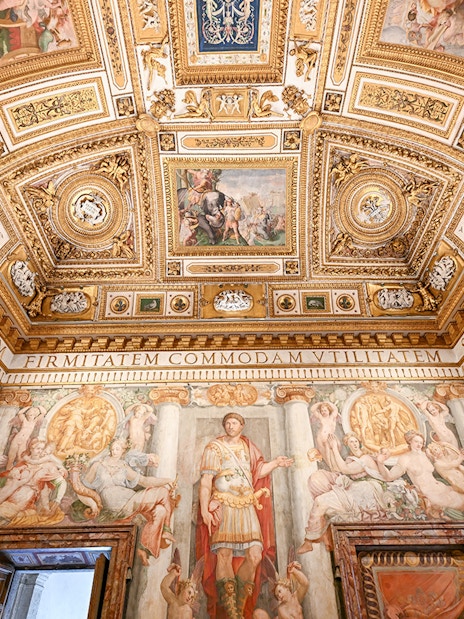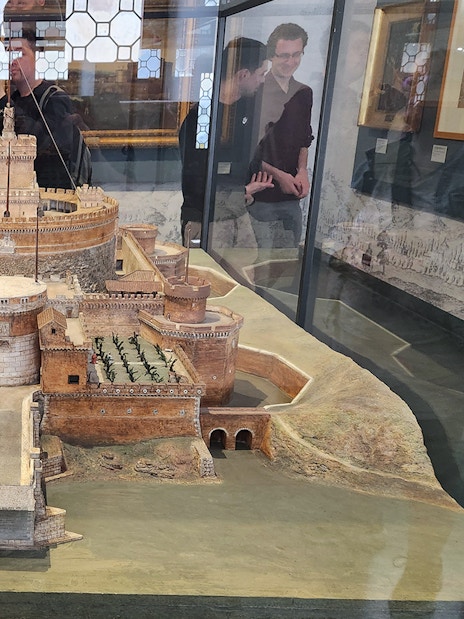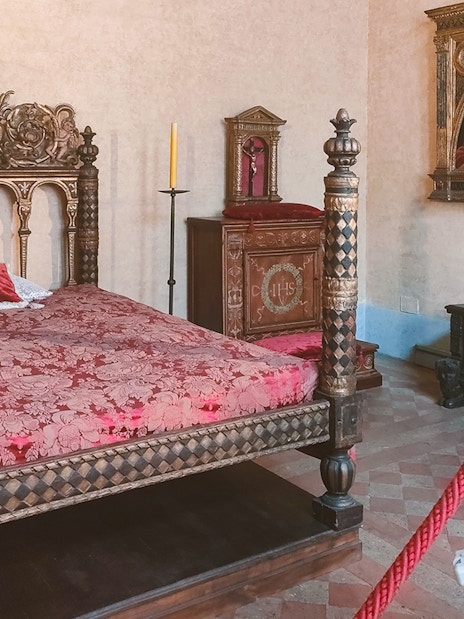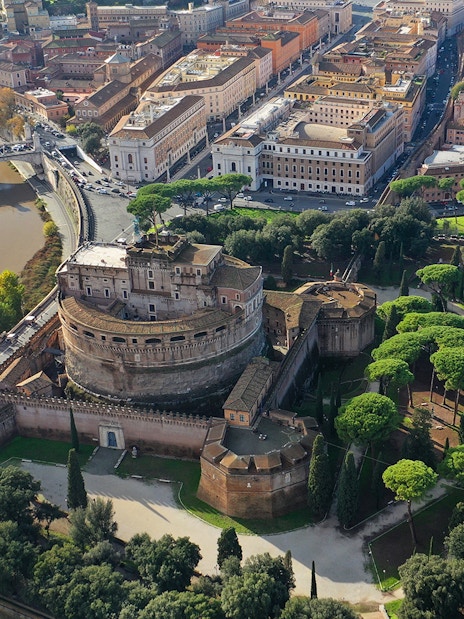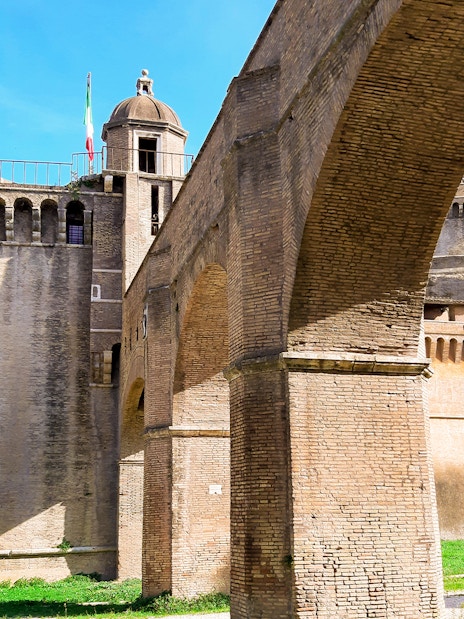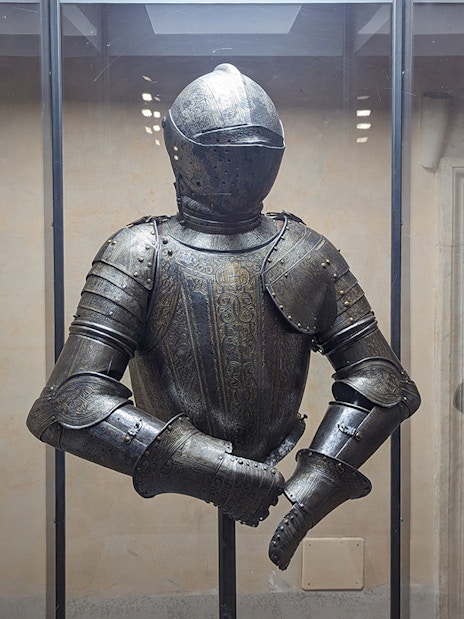- Colosseum
- Vatican Museums
- St. Peter's Basilica
- Rome Pantheon
- Musei Capitolini
- Roman Catacombs Tour
- Borghese Gallery
- Altare della Patria
- Doria Pamphilj Gallery
- Rome To Amalfi Coast Tours
- Rome To Tuscany Tours
- Bioparco Rome
- Big Bus Rome Hop-on Hop-off Tours
- Palazzo Barberini
- Leonardo da Vinci Museum
- Trevi Fountain Tours
Passetto di Borgo Tickets & Tours
Headout is an authorized and trusted partner of the venue, offering curated experiences to enjoy this attraction.

Get access to the hidden passageway running from the Vatican—with quick entry to the fortress.
- Everything you get: Enter the hidden corridor that once allowed popes to flee the Vatican in times of danger, then explore Castel Sant’Angelo, a museum steeped in Rome’s strategic heritage.
- Why choose this: This experience lets you trace the lesser known parts of Rome's medieval past. You can explore two iconic symbols of papal authority and protection at one go.
- Upgrades: Add a guided tour to Passetto di Borgo and learn about papal escapades, shadowy prisoner transfers, assassination plots and many more controversies associated with the corridor.
Get access to the hidden passageway running from the Vatican—with quick entry to the fortress.
- Everything you get: Enter the hidden corridor that once allowed popes to flee the Vatican in times of danger, then explore Castel Sant’Angelo, a museum steeped in Rome’s strategic heritage.
- Why choose this: This experience lets you trace the lesser known parts of Rome's medieval past. You can explore two iconic symbols of papal authority and protection at one go.
- Upgrades: Add a guided tour to Passetto di Borgo and learn about papal escapades, shadowy prisoner transfers, assassination plots and many more controversies associated with the corridor.
Inclusions
- Timed entry to Passetto di Borgo
- Fast-track entry to Castel Sant’Angelo
- Expert guide to Passetto di Borgo (as per option selected)
- English or Spanish speaking guide (as per option selected)
- Do not bring large bags or pets to the attraction.
- This experience is not accessible to wheelchair users.
- These tickets can't be cancelled or rescheduled.
Reviews
How do we collect reviews?
Snapshots from our guests
4.0
36 ratings
17
11
1
5
2
What our guests say
Jitte
May 2025Verified booking
It was a great experience in a small group on an amazing location. You get a unique point of view from both the borgo and st peters church. Would recommend it for sure
Mark
May 2025Verified booking
What I loved the most about this experience? First, the fact that one avoids the queue (by booking in advance). We were a small group (5 persons) and thus we had good time to admire the Passetto and taking pics. Also, the fact that we could visit Castel Sant'Angelo and had all the time to explore it by ourselves.
Antonella
Jun 2025Verified booking
We visited the Passetto from the Vatican to the Castel Sant Angelo. A Beautiful and unique experience 😃 we were ploughing only 5 people - the guide was very smiling and kind and let us know the history of the Popes Who used the Passetto. Very interesting and beautiful That this secret is now possible to visit. The film about the history Which was presented to us at the last was a gem.
View original review in Italian
Peter
May 2025Verified booking
It was a very good and binding organization: starting with the purchase of the ticket, then with the mail where the meeting point is exactly, then the punctual and uncomplicated reception, then the friendly staff who guided me through the Passetto - with enough time for the visit. I missed a bit more explanation about how this passetto was used and when it was particularly important. It would also have been good if we had been told about the special walk to the Vatican at the beginning.
View original review in German
Caroline
May 2025Verified booking
I think the entrance to the Passeto was not clearly marked...so we were late for our appointment, but thanks to the kindness of the guide we were able to join the next group! Thank you!
View original review in Dutch
Michael
May 2025Verified booking
We have passed the Castel Sant’Angelo on previous visits but were really pleased that we arranged entry tickets this time. The Passetto di Borgo has good views but was itself a little uninspiring. The Castel Sant’Angelo has a fascinating history and the one-way system allowed a good overview of the events through time. Great views of the Vatican and the river from the top of the Castel. This ticket just allows access to the Castel, we wished we had arranged an audio guide
Carisa
Jun 2025Verified booking
Really loved walking on the wall!
Salvatrice
May 2025Verified booking
All the artistic and scenic beauty
View original review in Italian
GUERIN
May 2025Verified booking
This experience is perfect for
View original review in French
Barbara
May 2025Verified booking
Beautiful experience ,many suggestive the passage in the passetto and castel sant' angelo wonderful
View original review in Italian
Carmen
Jul 2025Verified booking
jeff
Jul 2025Verified booking
Dianne
Jul 2025Verified booking
Severine
Jun 2025Verified booking
elvio
Jun 2025Verified booking
Amy
Jun 2025Verified booking
Daniela
Jun 2025Verified booking
Martha
Jun 2025Verified booking
Felix
May 2025Verified booking
Charles
May 2025Verified booking
Krystyna
May 2025Verified booking
Amanda
May 2025Verified booking
Juraj
May 2025Verified booking
Roberto
May 2025Verified booking
Debora
May 2025Verified booking
Combos
Combo (Save 5%): Castel Sant’Angelo & Passetto di Borgo + St. Peter’s Basilica Entry Tickets
from €33
€31.35
5% off
Step into Rome’s past at the mausoleum, feel faith at St. Peter’s tomb, and stroll the secret passage—no ticket lines, just timeless wonder.
- Everything you get at Castel Sant'Angelo: Arrive at your chosen slot and bypass the ticket queues to step right into the castle. Listen to the audio guide to navigate the spiral ramp and papal apartments at your pace. Get exclusive access to the the secret passageway connected to the Vatican castle.
- Everything you get at St. Peter's Basilica: Enjoy fast-track entry to St. Peter’s Basilica to explore its rich religious history. Visit papal tombs, admire Michelangelo’s Pietà and dome, and uncover Renaissance secrets with an insightful audio guide.
- Why choose this: From the fortress where popes plotted to the heart of Christianity where they led sacred rites, you can tour both by walking the elevated corridor.
Step into Rome’s past at the mausoleum, feel faith at St. Peter’s tomb, and stroll the secret passage—no ticket lines, just timeless wonder.
- Everything you get at Castel Sant'Angelo: Arrive at your chosen slot and bypass the ticket queues to step right into the castle. Listen to the audio guide to navigate the spiral ramp and papal apartments at your pace. Get exclusive access to the the secret passageway connected to the Vatican castle.
- Everything you get at St. Peter's Basilica: Enjoy fast-track entry to St. Peter’s Basilica to explore its rich religious history. Visit papal tombs, admire Michelangelo’s Pietà and dome, and uncover Renaissance secrets with an insightful audio guide.
- Why choose this: From the fortress where popes plotted to the heart of Christianity where they led sacred rites, you can tour both by walking the elevated corridor.
Inclusions
Castel Sant'Angelo
- Fast-track entry to Castel Sant’Angelo
- Access to Passetto di Borgo
St. Peter’s Basilica
- Fast-track entry to St. Peter's Basilica
- Access to digital audio guide
- Carry a valid photo ID at the redemption point.
- Do not bring hats, pets, or large bags to the venue.
- Remember this experience is not open to wheelchair users.
- Dress modestly at the basilica.
- These tickets can't be cancelled or rescheduled.
Reviews
How do we collect reviews?
Snapshots from our guests
3.9
177 ratings
83
45
19
10
20
What our guests say
Maxim
Jun 2025Verified booking
Followed the instructions and found the right entry pretty fast. Needed to wait about 10 minutes on the entry and another 10 minutes on security gate, which is nothing compared to the main waiting queue. The audio guide worked good and can be downloaded directly on site. It is not very extensive but is a good extra additionally to the tickets. The only downside was that the tickets weren't sent to us 1 day before the event. I had to contact the 24/7 support via chat at late afternoon. In the morning we had our tickets. -1 star for missing tickets, but +1 for top support. All in all totally worth the money.
Jitte
May 2025Verified booking
It was a great experience in a small group on an amazing location. You get a unique point of view from both the borgo and st peters church. Would recommend it for sure
Mark
May 2025Verified booking
What I loved the most about this experience? First, the fact that one avoids the queue (by booking in advance). We were a small group (5 persons) and thus we had good time to admire the Passetto and taking pics. Also, the fact that we could visit Castel Sant'Angelo and had all the time to explore it by ourselves.
Aydin
Jul 2025Verified booking
Admission with the ticket was great. Thank goodness everything worked online via the QR code, without a printout. There was a separate route for those with reserved tickets, so we got through without any problems or waiting. St. Peter's Basilica is a must-see.
View original review in German
Antonella
Jun 2025Verified booking
We visited the Passetto from the Vatican to the Castel Sant Angelo. A Beautiful and unique experience 😃 we were ploughing only 5 people - the guide was very smiling and kind and let us know the history of the Popes Who used the Passetto. Very interesting and beautiful That this secret is now possible to visit. The film about the history Which was presented to us at the last was a gem.
View original review in Italian
jean
Jun 2025Verified booking
We turned up at 12.15pm as requested and were turned away, asked to come back at 1pm. No audioguide and a long wait under the blazing sun because someone had a problem, so despite the 2 checkers everything came to a halt.
View original review in French
Manuela
Jun 2025Verified booking
It was absolutely worth the money! We didn't have to queue anywhere and were able to go straight to St. Peter's Basilica. Only at the gate into the cathedral did it take a maximum of 5 minutes. We are glad that we didn't have to stand in this endless queue in the blazing sun with a small child.
View original review in German
Fulvia
Jun 2025Verified booking
The experience skip-the-line tickets with audio guide included really very good. The guide essential and clear. The entrance really facilitated (we entered in about 15 minutes including controls). Only advice if possible to have the tickets received at the same time as payment. In my case they should have arrived 24 hours earlier but that was not the case and I had to prompt! They arrived in the morning for the visit in the afternoon.
View original review in Italian
Peter
May 2025Verified booking
It was a very good and binding organization: starting with the purchase of the ticket, then with the mail where the meeting point is exactly, then the punctual and uncomplicated reception, then the friendly staff who guided me through the Passetto - with enough time for the visit. I missed a bit more explanation about how this passetto was used and when it was particularly important. It would also have been good if we had been told about the special walk to the Vatican at the beginning.
View original review in German
Cheng
May 2025Verified booking
Good that I can skip the queue. one person can use the audio guide, it's ok, but better also provide full pdf version, as sometimes the venue is super noisy so difficult to hear the audio even set to the loudest volume.
Caroline
May 2025Verified booking
I think the entrance to the Passeto was not clearly marked...so we were late for our appointment, but thanks to the kindness of the guide we were able to join the next group! Thank you!
View original review in Dutch
Ilse
May 2025Verified booking
Everything went fine, we received the tickets via SMS the day before and were able to enter via skip the line without any problems.
View original review in Dutch
Michael
May 2025Verified booking
We have passed the Castel Sant’Angelo on previous visits but were really pleased that we arranged entry tickets this time. The Passetto di Borgo has good views but was itself a little uninspiring. The Castel Sant’Angelo has a fascinating history and the one-way system allowed a good overview of the events through time. Great views of the Vatican and the river from the top of the Castel. This ticket just allows access to the Castel, we wished we had arranged an audio guide
Jane
May 2025Verified booking
Skip-the-Line is the only way to go and this was really easy especially as for this trip the tickets were sent direct to my WhatsApp on the day without the need to go to an office and collect in advance. We particularly appreicated the audioguide which was downloadable in advance to listen to offline, during the visit and after. The commentary was excellent and had written explanation and photos as well as narration. And St Peter's is AMAZING!
Geanina
Jul 2025Verified booking
It's been awesome, lots of controls, but it goes pretty fast. Everything was great. Super recommended.
View original review in Spanish
JULIE
Jun 2025Verified booking
The cutter threads very well Medium guide audio
View original review in French
Bernd
Jun 2025Verified booking
Simple processing. Everything worked well.
View original review in German
Salvatrice
May 2025Verified booking
All the artistic and scenic beauty
View original review in Italian
Rui
May 2025Verified booking
Fast track entry with pre-booked tickets. The audio guide could have better inside church map locations
GUERIN
May 2025Verified booking
This experience is perfect for
View original review in French
Milena
May 2025Verified booking
Great way to save time and enter St. Peter's without standing in line
View original review in Italian
Rainer
May 2025Verified booking
There was no fast track entry. The audio guide was good.
View original review in German
Tabacaru
May 2025Verified booking
Impressed by the grandeur, beauty, art, organization...special .
This review is translated. Show original review.
Barbara
May 2025Verified booking
Beautiful experience ,many suggestive the passage in the passetto and castel sant' angelo wonderful
View original review in Italian
RANADAS
Jul 2025Verified booking
Castel Sant AngeloPassetto di Borgo
Make the most of Rome
Why visit Passetto di Borgo?

- Newly restored and reopened: After six years of restoration, the Passetto di Borgo is finally open to the public again. The once-hidden route now features museum exhibits, a restored trapdoor, and a new lighting system that reveals details previously lost in the dark.
- Legacy of 1900 years of defense: Built atop the 9th-century Leonine Wall, the corridor features thick stone walls and military stations once used by guards to monitor movement in the Borgo district. Its strategic location due its elevated design helped the guards suppress riots in the city.
- Walk the path of popes: You can walk the same route that was once taken by Pope Clement VII during Sack of Rome in 1527. He fled through the passage into the securities of Castel Sant’Angelo from the Apostolic Palace.
- Photography spots: The open-air part of the corridor offers contrasting panoramic views—with historic architecture of the Vatican on one side and modern cityscape of Rome on the other. You can click scenic photos here!
- Literary connection: Fans of Dan Brown's Angels & Demons will love the chance to see a real location from the novel, adding a layer of intrigue for visitors.
Ticket type
Is Passetto access included?
Why go for it?
Starting price
Recommended tickets
Standard entry
Yes
Get access to the exclusive secret passage, wander and explore it at your pace along with discovering the fortress.
Guided tour
Upgrade your entry tickets to include a guided tour
Learn about legends and secrets associated with the corridor, while discovering hideout points for guards.
Combo tours
Some combos offer access
Step into the shoes of popes and take the hidden passage from the castle to the basilica — a journey steeped in history, mystery, and intrigue.
What's to see inside?

Museum exhibits
At the Bastion of San Marco, sculpture groups by Giovanni Prini and a marble effigy of Pope Paul IV can be found in its museum exhibits.

Dual-level pathways
You can explore both upper (open air) and lower (enclosed) levels of the route with the former providing a scenic panoramic view of Rome.

Strategic watchtowers
The route has watchtowers built for surveillance purposes providing strategic advantage to the army.

Pope Alexander VI’s coat of arms
You can take a look at the coat of arms of Pope Alexander VI displayed on the inner wall of Passetto di Borgo.
Holy escapes: Popes who took the passage

Pope Alexander VI
In 1494, as Charles VIII of France entered Italy with a powerful army, his rapid approach toward Rome sent shockwaves through the city. Fearing for his safety, Pope Alexander VI made a dramatic escape through the Passetto di Borgo, the hidden corridor linking the Vatican to Castel Sant’Angelo. Shielded from public view, the elevated passage allowed him to slip away undetected and take refuge in the heavily fortified castle. This event underscored the strategic importance of the Passetto as a secret lifeline for the papacy during times of invasion and unrest.

Pope Clement VII
In 1527, during the Sack of Rome, Pope Clement VII fled through the Passetto di Borgo to Castel Sant'Angelo as the forces of Holy Roman Emperor Charles V invaded the city. Trapped in the castle for seven months, he witnessed the city’s devastation while the Swiss Guard bravely fought to protect him. Most of the Guard were massacred, their sacrifice ensuring Clement VII's survival and solidifying the Passetto's place in history as a symbol of papal resilience.
Know before you go
Timings
Location
Entrance
Facilities
Rules

Thursday to Sunday: 9 AM to 7:30 PM
Closed on: Monday, Tuesday, and Wednesday
Last admission: 6:30 PM
While specific daily schedules can vary, tours are generally offered during the daytime. It's advisable to check the latest timings and availability while booking your tickets.
Address: Viale Giuseppe Ceccarelli, 00193 Rome RM, Italy
Getting there
- By bus: Line 40
Closest bus stop: Risorgimento/Porta Angelica, 3-minute walk - By metro: Line A
Closest station: Ottaviano, 4-minute walk

The passage has two entrances, one from the San Marco Bastion of Castel Sant'Angelo and another near the Piazza della Città Leonina, just outside St. Peter’s Square, adjacent to the Vatican Walls. Make sure to check which entrance you need to report to for your tour.

- Restrooms: Within the passage there are no restrooms. However, in the fortress you may find restrooms on the lower levels and in the cafe at the terrace.
- Disabled access: Although elevators have been installed in the passage, only certain assisted tours provide wheelchair access.

- Food and Beverages: Eating and drinking are not permitted within the passageway. It's recommended to dine before or after the tour.
- Photography: While photography is generally allowed, flash photography may be restricted to preserve the artifacts and structure.
Frequently asked questions about Passetto di Borgo tickets
Is it necessary to book tickets in advance?
Yes, it's highly recommended to book tickets in advance, especially for guided tours, as they are in high demand and have limited slots.
What can be found on a tour of the passage?
On a tour to the Passetto di Borgo, you'll find a dual level pathway, with an open upper level passage and an enclosed corridor. In the enclosed corridor you will encounter narrow slits in walls that once served as military guard posts.
What can I do at the passetto?
You can walk along the Passetto di Borgo, learn about the papal history associated with it, enjoy its defensive architecture, and experience stunning views of Rome from various vantage points along the route.
Is there a dress code for visiting the passage?
There is no specific dress code for visiting Passetto di Borgo. However, it is advisable to wear comfortable shoes as the passageway is dimly lit and the surface is uneven.
Is photography allowed here?
Photography for personal use is allowed at Passetto di Borgo, however, there are restrictions on flash photography.
Is it wheelchair accessible?
Wheelchair accessibility is provided on special assisted tours. Your standard entry tickets may not provide access to wheelchair users.

